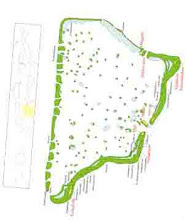
A few years ago I made an unforgettable trip to Indonesia. One of my favorite’s spots was the Borobodur Temple in Central Java. Not just because the Borobodur complex is one of the greatest monuments in the world but also because it was for about a century and a half it was the spiritual centre of Buddhism in Java. It was lost until its rediscovery in the eighteenth century, and for this reason it is of uncertain age. Nevertheless, it seams that it was built between the end of the seventh and beginning of the eighth century A.D. The structure is enormous and composed of 55,000 square meters of lava-rock is erected on a hill in the form of a stepped-pyramid of six rectangular storeys, three circular terraces and a central stupa forming the summit. The whole structure is in the form of a lotus flower, the sacred flower of Buddha. For each direction there are ninety-two Dhyani Buddha statues and 1,460 relief scenes. The lowest level has 160 reliefs depicting cause and effect; the middle level contains various stories of the Buddha's life from the Jataka Tales; the highest level has no reliefs or decorations whatsoever but has a balcony, square in shape with round walls: a circle without beginning or end. Here is the place of the ninety-two Vajrasattvas or Dhyani Buddhas tucked into small stupas. Each of these statues has a mudra (hand gesture) indicating one of the five directions: east, with the mudra of calling the earth to witness; south, with the hand position of blessing; west, with the gesture of meditation; north, the mudra of fearlessness; and the centre with the gesture of teaching. Besides being the highest symbol of Buddhism, the Borobodur is also a replica of the universe. It symbolizes the micro-cosmos, which is divided into three levels, in which man's world of desire is influenced by negative impulses; the middle level, the world in which man has control of his negative impulses and uses his positive impulses; the highest level, in which the world of man is no longer bounded by physical and worldly ancient desire. It is devotional practice to circumambulate around the galleries and terraces always turning to the left and keeping the edifice to the right while either chanting or meditating. In total, Borobodur represents the ten levels of a Bodhisattva's life which he or she must develop to become a Buddha or an awakened one. Borobodur is a place that touch us for the amazing structure, and makes us think about life and the universe that surround us.
















1 comentário:
Beautiful! Haven't been to Indonesia yet. Beautiful temples in Cambodia too !
Enviar um comentário